Rib Stress Fractures: Prevention Exercises
 | From a Boathouse Doc article, first published in American Rowing magazine, by:
Dean Pinciotti, PT
Jeff Erickson, MPT
Dr. Timothy Hosea, MD
Sports Physical Therapy
743 ALEXANDER ROAD, SUITE #2
PRINCETON, NJ 08540
PHONE (609) 419-0455
FAX (609) 419-0023
[email protected] |
Rib stress fractures, like any stress fracture are an overuse injury, secondary to excessive stress on the ribs. They generally occur in the 5th to 9th ribs and are associated with periods of intensive training, either on the water or on the ergometer. The primary hallmark of prevention is avoiding excessive loading of the ribs, such as rowing long steady state pieces at a low cadence against the current and into the headwind. In conditions such as those, clams may be utilized to "lighten" the load, and prevent excessive stress on the ribs. Likewise on the ergometer, the damper should not be set higher than 3 for long pieces at a low stroke rate.
In addition to modifying training techniques, we would recommend a program of rib strengthening exercises incorporated into their circuit training. The exercises are designed to strength the serratus anterior that is an important scapular stabilizer and with the external oblique is a primary source of rib deformation during the rowing stroke.
There are four exercises, which we feel would be helpful in strengthening the ribs and preventing stress fractures.
| #1: PUSH UP PLUS :
The rower is in a prone position with the legs on the floor or a straight bench.
- With the arms straight and the shoulder and back in a level position, push upward causing the thoracic region to become rounded.
- Hold for 7 seconds, then slowly relax.
|
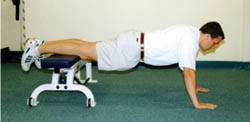
Start Position |
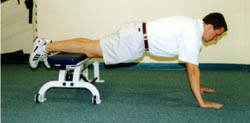
End Position |
Perform 2-3 sets of 10-20 repetitions with a 1-3 minute rest period
|
|
| #2: SERRATUS PRESS (fig 2a and 2b):
The athlete begins either flat on the back or at a 45-degree incline
- With the weight centered over the chest and the elbows extended fully, the weight is pressed toward the ceiling
- Hold the press for 5-7 seconds and slowly relax. DO NOT bend the elbows until one set has been completed.
|
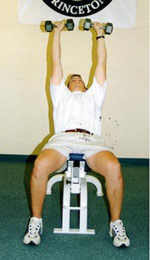
Start Position |
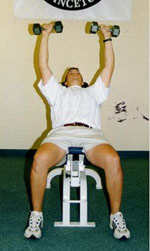
End Position |
|
| #3: UPPER EXTREMITY STEP UPS (fig 3a and 3b):
This is a weight bearing exercise to stabilize the scapular muscles. The height can be adjusted, start with 2 inches and increase in 2-inch increments. Body position begins with a kneeling position to a full push up position (pictured), to a foot elevated position over several weeks. Proper form of arms straight, level shoulders and back must be maintained before changing position or resistance.
- The rower begins in a push-up position (arms straight, shoulders and back level), facing the step.
- The rower weight shifts onto one arm while stepping onto the plate
- The opposite arm follows, so both arms are placed up on the step.
- The rower then steps down alternating the arms.
- Perform 2-3 sets of 10-20 repetitions with 1-3 minute rest period. Increase to 4-5 sets of 20-30 with proper form.
|
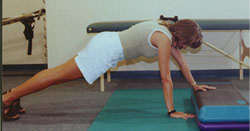
Start and End Position |

Mid Position |
| To challenge the rowers further, the program can be adjusted to intensify the exercise by performing exercise on an unstable base such as a wobble board, or Swiss ball. Also wheelbarrow races can be instituted to increase the strengthening effect of this exercise. |
|
| #4: SERRATUS RHYTHMIC STABILIZATION (fig 4a and 4b):
- The rower sits or stands upright with good posture.
- Begin with the arm held at a 90-degree angle of forward elevation, then press/push the weight forward.
- While holding the weight forward, spell the alphabet or make the star shape with the arm, keeping the elbow locked in full extension.
|
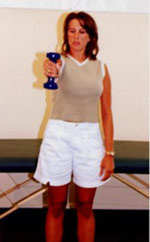 |
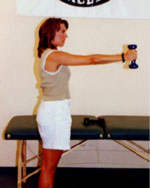 |
| Perform 2-3 sets of 10-20 repetitions with a 1-3 minute rest period. |
|